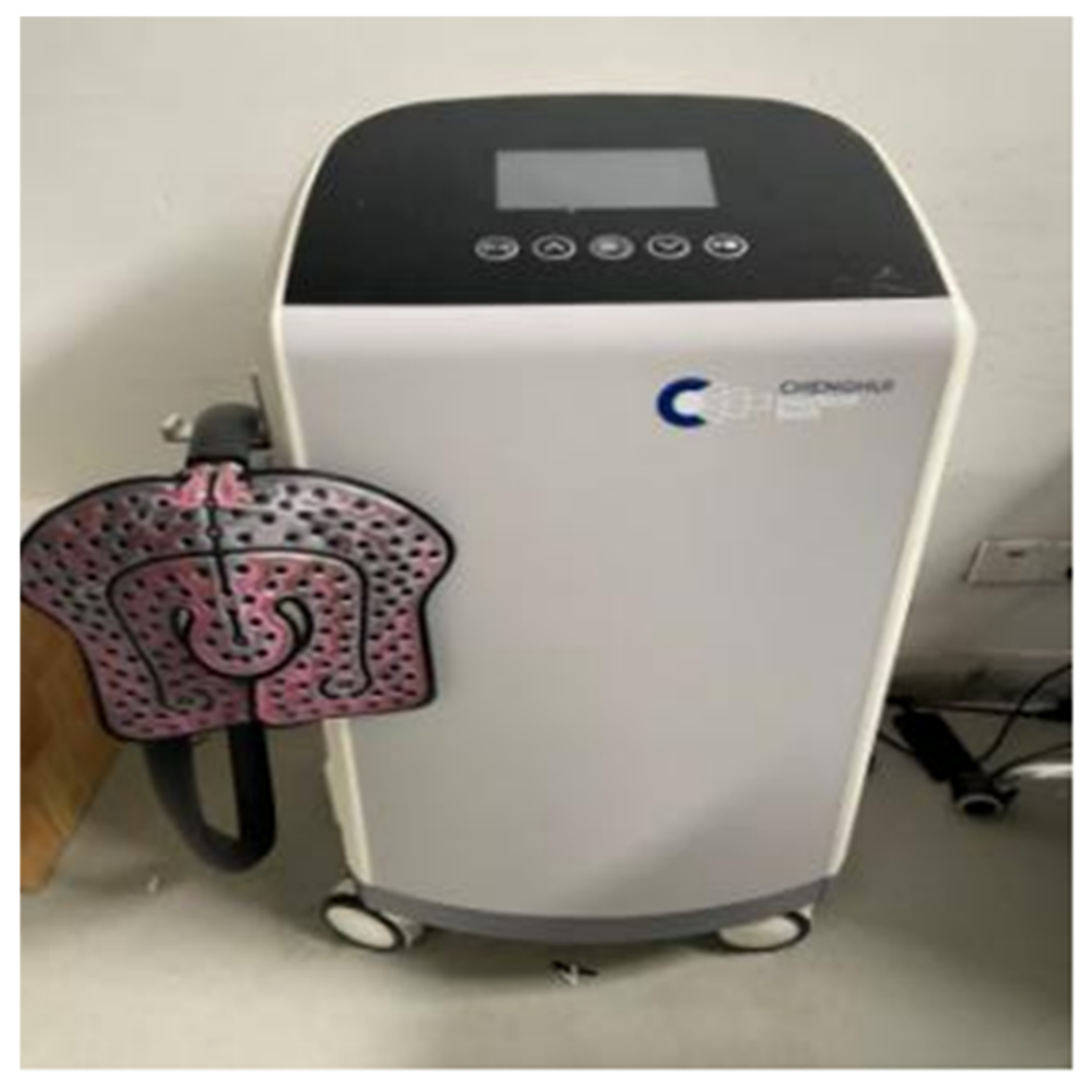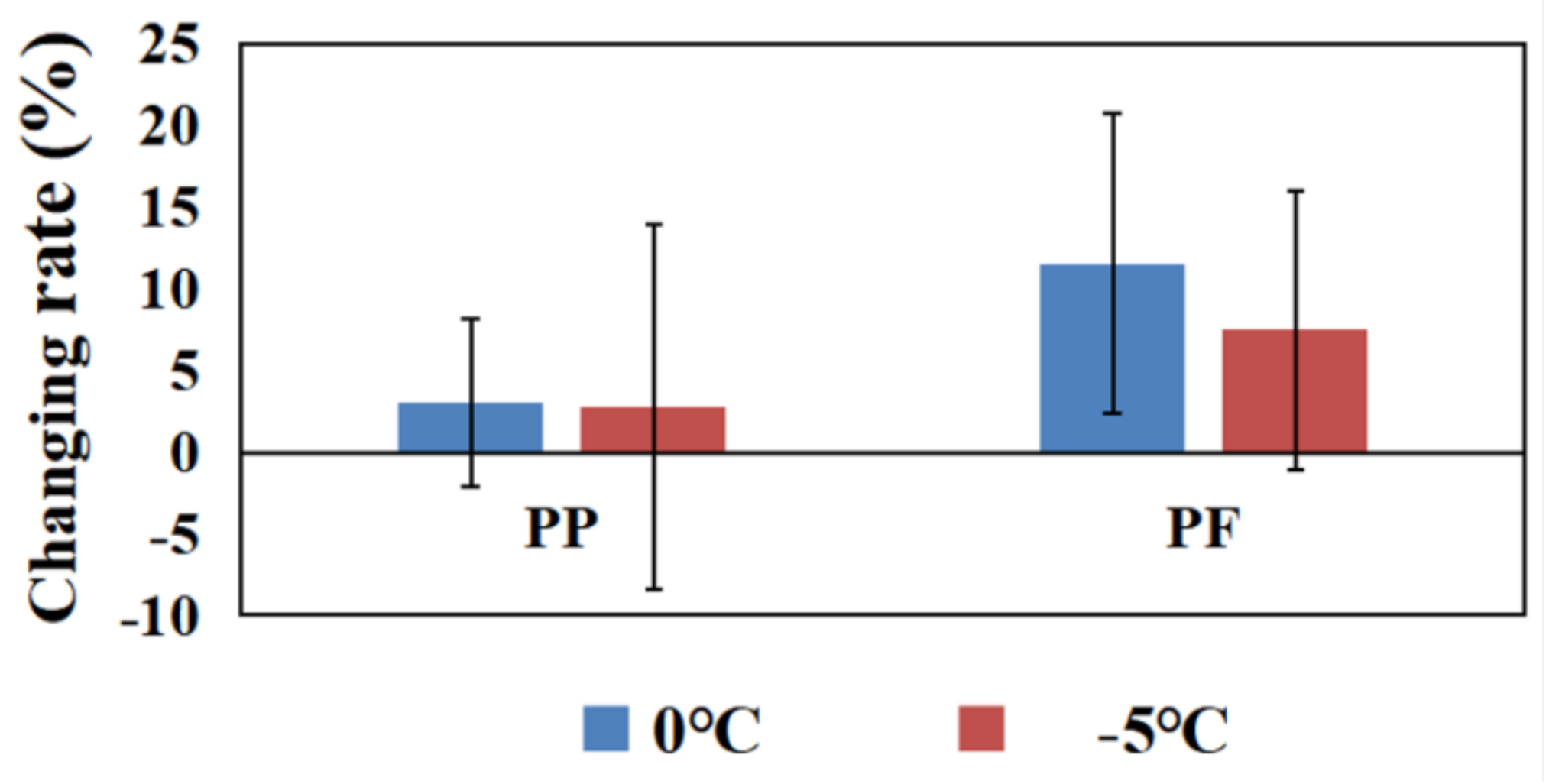Effect of Cryotherapy Temperature on the Extension Performance of Healthy Adults’ Legs
Abstract
:Simple Summary
Abstract
1. Introduction
2. Materials and Methods
2.1. Participants
2.2. Experimental Design
2.3. Instrumentation
2.4. Data Statistics and Analysis
3. Results
3.1. Experimental One-Effect of PP and PF in 0 °C Cryotherapy
3.2. Experimental Two-Effect of PP and PF in −5 °C Cryotherapy
3.3. Changing Rates of PP and PF between 0 °C and −5 °C Cryotherapy
4. Discussion
5. Conclusions
Author Contributions
Funding
Institutional Review Board Statement
Informed Consent Statement
Data Availability Statement
Conflicts of Interest
References
- Bleakley, C.; McDonough, S.; MacAuley, D. The use of ice in the treatment of acute soft-tissue injury: A systematic review of randomized controlled trials. Am. J. Sports Med. 2004, 32, 251–261. [Google Scholar] [CrossRef] [PubMed]
- Fukuchi, C.A.; Duarte, M.; Stefanyshyn, D.J. Postural sway following cryotherapy in healthy adults. Gait Posture 2014, 40, 262–265. [Google Scholar] [CrossRef] [PubMed]
- Knight, K.L. Cryotherapy in Sport Injury Management; Human Kinetics Publishers: Champaign, IL, USA, 1995. [Google Scholar]
- Algafly, A.A.; George, K.P. The effect of cryotherapy on nerve conduction velocity, pain threshold and pain tolerance. Br. J. Sports Med. 2007, 41, 365–369. [Google Scholar] [CrossRef]
- Nadler, S.F.; Weingand, K.; Kruse, R.J. The physiologic basis and clinical applications of cryotherapy and thermotherapy for the pain practitioner. Pain Physician 2004, 7, 395–400. [Google Scholar] [CrossRef]
- Douglas, M.; Bivens, S.; Pesterfield, J.; Clemson, N.; Castle, W.; Sole, G.; Wassinger, C.A. Immediate effects of cryotherapy on static and dynamic balance. Int. J. Sports Phys. Ther. 2013, 8, 9–14. [Google Scholar]
- Magnusson, M.; Enbom, H.; Johansson, R.; Wiklund, J. Significance of pressor input from the human feet in lateral postural control. The effect of hypothermia on galvanically induced body-sway. Acta Otolaryngol. 1990, 110, 321–327. [Google Scholar] [CrossRef] [PubMed]
- Wang, H.K.; Chen, C.H.; Shiang, T.Y.; Jan, M.H.; Lin, K.H. Risk-factor analysis of high school basketball-player ankle injuries: A prospective controlled cohort study evaluating postural sway, ankle strength, and flexibility. Arch. Phys. Med. Rehabil. 2006, 87, 821–825. [Google Scholar] [CrossRef] [PubMed]
- Schmid, S.; Moffat, M.; Gutierrez, G.M. Effect of knee joint cooling on the electromyographic activity of lower extremity muscles during a plyometric exercise. J. Electromyogr. Kines. 2010, 20, 1075–1081. [Google Scholar] [CrossRef] [PubMed]
- Wang, H.; Toner, M.M.; Lemonda, T.J.; Zohar, M. Changes in landing mechanics after cold-water immersion. Res. Q. Exerc. Sport 2010, 81, 127–132. [Google Scholar] [CrossRef]
- Macedo, C.S.G.; Vicente, R.C.; Cesario, M.D.; Rinaldo, R.J.G. Cold-water immersion alters muscle recruitment and balance of basketball players during vertical jump landing. J. Sport Sci. 2016, 34, 348–357. [Google Scholar] [CrossRef] [PubMed]
- Bleakley, C.M.; O’Connor, S.; Tully, M.A.; Rocke, L.G.; Macauley, D.C.; Mcdonough, S.M. The PRICE study (Protection Rest Ice Compression Elevation): Design of a randomised controlled trial comparing standard versus cryokinetic ice applications in the management of acute ankle sprain. BMC Musculoskel. Dis. 2007, 19, 8125. [Google Scholar] [CrossRef]
- António, A.; Marco, L.; António, N.R.; Sérgio, M.; José, M. Effects of cold water immersion on the recovery of physical performance and muscle damage following a one-off soccer match. J. Sport Sci. 2011, 29, 217–225. [Google Scholar]
- Taichi, Y.; Kojiro, I. Effects of static stretching for 30 seconds and dynamic stretching on leg extension power. J. Strength Cond. Res. 2005, 19, 677–683. [Google Scholar]
- Bassey, E.J.; Short, A.H. A new method for measuring power output in a single leg extension: Feasibility, reliability and validity. Eur. J. Appl. Physiol. 1990, 60, 385–390. [Google Scholar] [CrossRef]
- Myrer, J.W.; Measom, G.; Fellingham, G.W. Temperature changes in the human leg during and after two methods of cryotherapy. J. Athl. Train. 1998, 33, 25–29. [Google Scholar] [PubMed]
- Stephen, J.K.; Mitchell, L.C.; Gallen, K.J.; Smith, J.C.; Moore, J.B. The Effects of Cryotherapy on Ground-Reaction Forces Produced during a Functional Task. J. Sport Rehabil. 2000, 9, 3–14. [Google Scholar]
- Greg, J.R.; Aaron, J.C.; Peter, R.; Stephen, H. Effects of cold-water immersion on physical performance between successive matches in high-performance junior male soccer players. J. Sport Sci. 2009, 27, 565–573. [Google Scholar]
- Costello, J.T.; Algar, L.A.; Donnelly, A.E. Effects of whole—Body cryotherapy (−110 °C) on proprioception and indices of muscle damage. Scand. J. Med. Sci. Sports 2012, 22, 190–198. [Google Scholar] [CrossRef] [Green Version]
- Hohenauer, E.; Taeymans, J.; Baeyens, J.; Clarys, P.; Clijsen, R. The Effect of Post-Exercise Cryotherapy on Recovery Characteristics: A Systematic Review and Meta-Analysis. PLoS ONE 2015, 10, e0139028. [Google Scholar] [CrossRef]
- Merrick, M.A.; Knight, K.L.; Ingersoll, C.D.; Potteiger, J.A. The effects of ice and compression wraps on intramuscular temperatures at various depths. J. Athl. Train. 1993, 28, 236–245. [Google Scholar]
- Bonde, P.F.; Schultz, P.L.; Dragsted, N. Peripheral and central blood flow in man during cold, thermoneutral, and hot water immersion. Aerosp. Med. Hum. Perf. 1992, 63, 346–350. [Google Scholar]
- Covington, D.B.; Bassett, F.H. When cryotherapy injuries: The danger of peripheral nerve damage. Physician Sportsmed. 1993, 21, 78–93. [Google Scholar] [CrossRef] [PubMed]
- Oliveira, R.; Ribeiro, F.; Oliveira, J. Cryotherapy Impairs Knee Joint Position Sense. Int. J. Sports Med. 2010, 31, 198–201. [Google Scholar] [CrossRef]
- Kanlayanaphotporn, R.; Janwantanakul, P. Comparison of skin surface temperature during the application of various cryotherapy modalities. Arch. Phys. Med. Rehabil. 2005, 86, 1411–1415. [Google Scholar] [CrossRef] [PubMed]
- Sargeant, A.J. Effect of muscle temperature on leg extension force and short-term power output in humans. Eur. J. Appl. Physiol. 1987, 56, 693–698. [Google Scholar] [CrossRef] [PubMed]
- Rutkove, S.B. Effects of temperature on neuromuscular electrophysiology. Muscle Nerve. 2001, 24, 867–882. [Google Scholar] [CrossRef] [PubMed]
- Eldred, E.; Lindsley, D.F.; Buchwald, J.S. The effect of cooling on mammalian muscle spindles. Exp. Neurol. 1960, 2, 144–157. [Google Scholar] [CrossRef]
- Point, M.; Guilhem, G.; Hug, F.; Nordez, A.; Frey, A.; Lacourpaille, L. Cryotherapy induces an increase in muscle stiffness. Scand. J. Med. Sci. Sports 2018, 28, 260–266. [Google Scholar] [CrossRef]
- Bleakley, C.; Costello, J.; Glasgow, P. Should athletes return to sport after applying ice? A systematic review of the effect of local cooling on functional performance. Sports Med. 2012, 42, 69–87. [Google Scholar] [CrossRef] [Green Version]
- Rui, T.; Filipa, S.; Vera, P.; João, F.; Alexandre, L. The Acute Effect of Cryotherapy on Muscle Strength and Shoulder Proprioception. J. Sport Rehabil. 2017, 26, 497–506. [Google Scholar]
- Pritchard, K.A.; Saliba, S.A. Should Athletes Return to Activity after Cryotherapy? J. Athl. Train. 2014, 49, 95–96. [Google Scholar] [CrossRef] [PubMed] [Green Version]
- Bergh, U.; Ekblom, B. Influence of muscle temperature on maximal muscle strength and power output in human skeletal muscles. Acta Phyciol. 1979, 107, 33–37. [Google Scholar] [CrossRef]
- Vangaard, L. Physiological reactions to wetcold. Arrat. Space Environ. Med. 1975, 46, 33–36. [Google Scholar]
- Hopkins, J.T. Knee Joint Effusion and Cryotherapy Alter Lower Chain Kinetics and Muscle Activity. J. Athl. Train. 2006, 41, 177–184. [Google Scholar]
- Kimberly, A.R.; Noelle, M.S.; William, R.P.; Ingersoll, C.D.; Weltman, A.L.; Saliba, S.A. The Effect of Cold Water Immersion on 48-Hour Performance Testing in Collegiate Soccer Players. J. Strength Cond. Res. 2012, 26, 2043–2050. [Google Scholar]




| Age (Years) | Height (cm) | Weight (kg) | |
|---|---|---|---|
| Participant (n = 31) | 39.94 ± 12.16 | 162.59 ± 6.16 | 60.53 ± 9.96 |
| Index | Before | After | p Value | Δ(After–Before) | 95% CI | t | df |
|---|---|---|---|---|---|---|---|
| PP (W) | 762.84 ± 289.33 | 784.77 ± 298.93 | 0.003 | 21.93 ± 9.60 * | −35.92~−7.95 | −3.203 | 30 |
| PF (Lb) | 375.90 ± 125.80 | 414.48 ± 125.75 | 0 | 38.58 ± 0.05 * | −55.48~−21.68 | −4.662 | 30 |
| Index | Before | After | p Value | Δ(After–Before) | 95% CI | t | df |
|---|---|---|---|---|---|---|---|
| PP (W) | 804.45 ± 339.57 | 807.16 ± 307.62 | 0.85 | 2.71 ± 31.95 | −31.79~26.37 | −0.19 | 30 |
| PF (Lb) | 406.58 ± 138.66 | 431.39 ± 133.99 | 0 | 24.81 ± 4.67 * | −36.55~−13.07 | −4.36 | 30 |
Publisher’s Note: MDPI stays neutral with regard to jurisdictional claims in published maps and institutional affiliations. |
© 2021 by the authors. Licensee MDPI, Basel, Switzerland. This article is an open access article distributed under the terms and conditions of the Creative Commons Attribution (CC BY) license (https://creativecommons.org/licenses/by/4.0/).
Share and Cite
Lu, Y.; He, Y.; Ying, S.; Wang, Q.; Li, J. Effect of Cryotherapy Temperature on the Extension Performance of Healthy Adults’ Legs. Biology 2021, 10, 591. https://doi.org/10.3390/biology10070591
Lu Y, He Y, Ying S, Wang Q, Li J. Effect of Cryotherapy Temperature on the Extension Performance of Healthy Adults’ Legs. Biology. 2021; 10(7):591. https://doi.org/10.3390/biology10070591
Chicago/Turabian StyleLu, Yichen, Yuqi He, Shanshan Ying, Qiaojun Wang, and Jianshe Li. 2021. "Effect of Cryotherapy Temperature on the Extension Performance of Healthy Adults’ Legs" Biology 10, no. 7: 591. https://doi.org/10.3390/biology10070591
APA StyleLu, Y., He, Y., Ying, S., Wang, Q., & Li, J. (2021). Effect of Cryotherapy Temperature on the Extension Performance of Healthy Adults’ Legs. Biology, 10(7), 591. https://doi.org/10.3390/biology10070591






